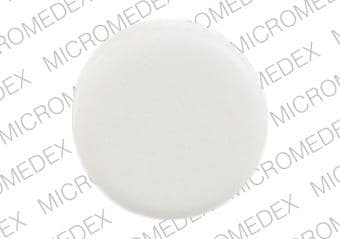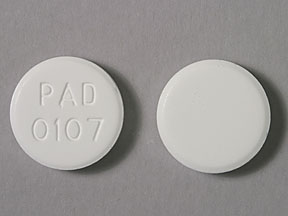Dosage Forms
Excipient information presented when available (limited, particularly for generics); consult specific product labeling.
Lozenge, Mouth/Throat:
Generic: 10 mg (70 ea, 140 ea)
Troche, Mouth/Throat:
Generic: 10 mg
Pharmacology
Mechanism of Action
Binds to phospholipids in the fungal cell membrane altering cell wall permeability resulting in loss of essential intracellular elements
Pharmacokinetics/Pharmacodynamics
Distribution
Oral: Inhibitory concentrations remain in the saliva for up to 3 hours after dissolution of the troche
Use: Labeled Indications
Oropharyngeal candidiasis (treatment): Local treatment of oropharyngeal candidiasis.
Oropharyngeal candidiasis (prophylaxis): To reduce the incidence of oropharyngeal candidiasis in immunocompromised patients undergoing chemotherapy, radiotherapy, or steroid therapy utilized in the treatment of leukemia, solid tumors, or renal transplantation.
Contraindications
Hypersensitivity to clotrimazole or any component of the formulation
Documentation of allergenic cross-reactivity for antifungals is limited. However, because of similarities in chemical structure and/or pharmacologic actions, the possibility of cross-sensitivity can not be ruled out with certainty.
Dosage and Administration
Dosing: Adult
Oropharyngeal candidiasis (prophylaxis): Oral: 10 mg dissolved slowly 3 times daily for the duration of chemotherapy or until steroids are reduced to maintenance levels.
Oropharyngeal candidiasis (treatment): Oral: 10 mg dissolved slowly 5 times daily for 14 consecutive days. Note: When used for initial treatment in patients with HIV-1, duration of therapy is 7 to 14 days (DHHS [adult] 2014; DHHS [pediatric] 2013).
Dosing: Geriatric
Refer to adult dosing.
Dosing: Pediatric
Candidiasis, oropharyngeal; treatment: Children ≥3 years and Adolescents: Oral: 10 mg troche dissolved slowly 5 times daily for 14 consecutive days. Note: When used for initial treatment in patients with HIV, duration of therapy is 7 to 14 days (HHS [OI adult 2016]; HHS [OI pediatric 2016]).
Administration
Oral: Allow troche to dissolve slowly in the mouth. Dissolution is complete in approximately 30 minutes.
Storage
Store at 20°C to 25°C (68°F to 77°F). Avoid freezing.
Clotrimazole (Oral) Images
Drug Interactions
ARIPiprazole: CYP3A4 Inhibitors (Weak) may increase the serum concentration of ARIPiprazole. Management: Monitor for increased aripiprazole pharmacologic effects. Aripiprazole dose adjustments may or may not be required based on concomitant therapy and/or indication. Consult full interaction monograph for specific recommendations. Monitor therapy
Dofetilide: CYP3A4 Inhibitors (Weak) may increase the serum concentration of Dofetilide. Monitor therapy
Flibanserin: CYP3A4 Inhibitors (Weak) may increase the serum concentration of Flibanserin. Monitor therapy
Lemborexant: CYP3A4 Inhibitors (Weak) may increase the serum concentration of Lemborexant. Management: The maximum recommended dosage of lemborexant is 5 mg, no more than once per night, when coadministered with weak CYP3A4 inhibitors. Consider therapy modification
Lomitapide: CYP3A4 Inhibitors (Weak) may increase the serum concentration of Lomitapide. Management: Patients on lomitapide 5 mg/day may continue that dose. Patients taking lomitapide 10 mg/day or more should decrease the lomitapide dose by half. The lomitapide dose may then be titrated up to a max adult dose of 30 mg/day. Consider therapy modification
Neratinib: Clotrimazole (Oral) may increase the serum concentration of Neratinib. Management: Avoid concomitant use of neratinib and clotrimazole if possible. If combined, monitor for increased neratinib effects/toxicities. Consider therapy modification
NiMODipine: CYP3A4 Inhibitors (Weak) may increase the serum concentration of NiMODipine. Monitor therapy
Pimozide: CYP3A4 Inhibitors (Weak) may increase the serum concentration of Pimozide. Avoid combination
Tacrolimus (Systemic): Clotrimazole (Oral) may increase the serum concentration of Tacrolimus (Systemic). Monitor therapy
Triazolam: CYP3A4 Inhibitors (Weak) may increase the serum concentration of Triazolam. Management: Consider triazolam dose reduction in patients receiving concomitant weak CYP3A4 inhibitors. Consider therapy modification
Ubrogepant: CYP3A4 Inhibitors (Weak) may increase the serum concentration of Ubrogepant. Management: In patients taking weak CYP3A4 inhibitors, the initial and second dose (if needed) of ubrogepant should be limited to 50 mg. Consider therapy modification
Adverse Reactions
>10%: Hepatic: Abnormal liver function tests
Frequency not defined:
Dermatologic: Pruritus
Gastrointestinal: Nausea, vomiting
Warnings/Precautions
Concerns related to adverse effects:
- Hepatic effects: Abnormal LFTs have been reported, including abnormal aspartate aminotransferase (AST). Elevations are usually minimal. Monitor LFTs periodically, especially in patients with preexisting hepatic impairment.
Disease-related concerns:
- Hepatic impairment: Use with caution; abnormal LFTs have been reported. Elevations are usually minimal. Monitor LFTs periodically.
- Systemic fungal infection: Clotrimazole should not be used for treatment of systemic fungal infection.
Concurrent drug therapy related concerns:
- Drug-drug interactions: Potentially significant interactions may exist, requiring dose or frequency adjustment, additional monitoring, and/or selection of alternative therapy. Consult drug interactions database for more detailed information.
Other warnings/precautions:
- Administration: Clotrimazole must be slowly dissolved in the mouth for maximum efficacy.
Monitoring Parameters
Consider KOH test or culture prior to treatment to confirm oropharyngeal candidiasis; periodic liver function tests during therapy.
Pregnancy
Pregnancy Risk Factor
C
Pregnancy Considerations
Adverse events have been observed in animal reproduction studies.
Patient Education
What is this drug used for?
- It is used to treat or prevent fungal infections in the mouth.
Frequently reported side effects of this drug
- Itching
- Nausea
- Vomiting
- Numbness or tingling in mouth
Other side effects of this drug: Talk with your doctor right away if you have any of these signs of:
- Liver problems like dark urine, fatigue, lack of appetite, nausea, abdominal pain, light-colored stools, vomiting, or yellow skin.
- Signs of a significant reaction like wheezing; chest tightness; fever; itching; bad cough; blue skin color; seizures; or swelling of face, lips, tongue, or throat.
Note: This is not a comprehensive list of all side effects. Talk to your doctor if you have questions.
Consumer Information Use and Disclaimer: This information should not be used to decide whether or not to take this medicine or any other medicine. Only the healthcare provider has the knowledge and training to decide which medicines are right for a specific patient. This information does not endorse any medicine as safe, effective, or approved for treating any patient or health condition. This is only a brief summary of general information about this medicine. It does NOT include all information about the possible uses, directions, warnings, precautions, interactions, adverse effects, or risks that may apply to this medicine. This information is not specific medical advice and does not replace information you receive from the healthcare provider. You must talk with the healthcare provider for complete information about the risks and benefits of using this medicine.


